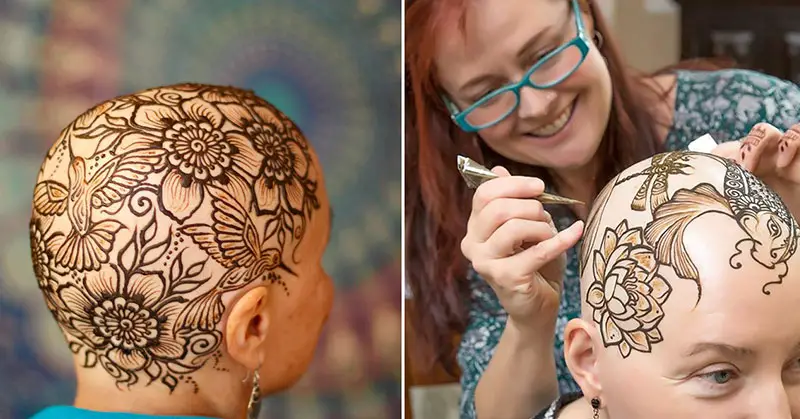Hair loss from chemotherapy or alopecia doesn’t have to be covered up with wigs, scarves, or caps. In fact, it doesn’t need to be covered at all if that’s what you want. However, some women are now choosing to decorate their hair with beautiful henna patterns to showcase their strength, struggle, and triumph to the world [1].
Chemotherapy is the most common treatment option for cancer, and it can come with a host of side effects. Hair loss is one of them, and it can be disheartening to experience during a battle with cancer. Chemotherapy medications are intended to destroy cancer cells. However, as many know, they negatively affect healthy cells as well, and this includes any that grow hair on our bodies.
Chemo eventually leads to hair loss all over the body, not just the scalp. Uncontrollable hair loss can also be caused by a host of other physical and mental conditions, such as alopecia areata, an autoimmune condition in which hair is lost from some or all areas of the scalp and body.
To wake up in the morning and find a large patch of hair on your pillow or tiny fibers all over your sheets is heartbreaking. Reports from a study conducted in 2010 showed that 47% of women undergoing chemo describe hair loss as the “most traumatic aspect” of the treatment [2]. It can be hard to predict when a patient will lose their hair and or what rate, but it’s a heartbreaking process regardless.
Henna crowns and words unspoken

Henna dye is used in many places around the world for spiritual, cultural, and aesthetic purposes. Henna is made from the seeds of the Hina plant and is used to stain the skin with long-lasting and penetrating patterns. In some Arabic traditions, the length of time a bride’s henna lasts on her hands signifies the length of her honeymoon. In Morocco, doors are painted with henna to welcome spirits of prosperity and drive away evil. For others, henna is an alternative to tattoos and is simply used to decorate the body.
Henna crowns on the bare scalp have been around for a long time, mostly worn to portray a person’s religious or spiritual significance.
Leah Reddell, a Denver-based henna artist found a use for henna in giving women with cancer a positive side to hair loss. With over 12 years of experience in the business, Reddell is the primary artist for Face Fiesta and Denver Henna. She started providing henna crowns when some of her clients dealing with chemo requested them. She wrote on Instagram that a lot of her ladies specifically request elements that mean something to them to be incorporated into their patterns.
“Part of what makes henna crowns so special for me is incorporating important symbols or elements that are significant to the person wearing the crown. Also, I love a good challenge!! The request here was for Otters, Lotuses, and Dragonflies. From my client: Otters represent “going with the flow and playfulness; the Lotus blossom is for beauty out of ugliness; and the Dragonfly is for making the most of life and rising above hardship,” Reddell wrote.
While henna crowns are mostly worn by women, men and kids going through hair loss can also choose to have them done.
These lovely ink patterns on the scalp provide a way for a person to say so much without any words. The patterns, the elements, the contours, and rhythm all come together to pass on a message dripping with strength and resilience, showing so much pride and bravery in the face of a painful struggle.
“Sometimes I can’t believe I get to do this,” says Reddell. “I’m always amazed at the adventures my art gets to have out there in the world once it leaves me, and the fact that my art gets to be on these women, to embody and to change the experience they’re having in a positive way, is one of the best things I get to do.”
Looking to the bright side

Lots of people don’t understand that “politely asking” could still be offensive. A person dealing with hair loss from chemo might not want to talk about it. They don’t want to be pitied, hounded with questions or given unsolicited advice about what would look best on them. However, people are definitely going to talk. Henna crowns give whoever wears them an air of confidence and something to be excited about. Instead of drawing feelings and words of pity from people, they would inspire admiration and cheer.
“People in public approach them to talk about the art they’re wearing, not just the cancer they’re dealing with,” says Reddell. “Also, many women simply don’t like wearing wigs and scarves—the crowns help them embrace their baldness in a beautiful way.”
Reddell says that the henna crowns have helped women cope with the condition in so many ways. Even before they had their first chemo session, some clients already opted to shave off their hair and have their henna crowns done. The entire experience would often be less traumatic as they get in front of the pain, giving themselves a real sense of control.
“They wanted to feel good in that moment (not sick with chemo) and confront [and] embrace baldness on their own terms. They feel excited and empowered, out there in the world, owning the art they’re wearing,” she says
Final verdict: Go for it
Henna crowns are truly amazing! If you’re not sure whether to go for or you’re worried about what people would say, here’s a boost of confidence: “DO IT, DO IT, DO IT!” We’re rooting for you because you’re beautiful regardless of the amount of hair on your head. Pour your emotions into the patterns you’d select and wear your strength like a crown. Your henna crown would always be a reminder that no matter what cancer has taken from you, you’re still in charge.
“Seriously, I’ve never had a client regret getting a crown—I’ve only had clients regret that they didn’t do it earlier in their treatments,” Reddell says.
However, it’s important to ensure that your artist uses the right kind of henna to prevent side effects from arising in the future. According to the American Academy of Dermatology, henna mixed with p-Phenylenediamine (PPD) is dangerous and can cause intense itching, scaring, and inflammation. This chemical is an illegal additive often added to make the ink last longer.
“I can’t say enough about the importance of using real, handmade, natural henna for henna crowns. Real henna paste is handmade with very simple ingredients and must be kept frozen” says Reddell.
Keep Reading: 50 Weird Signs That Lead To a Cancer Diagnosis

